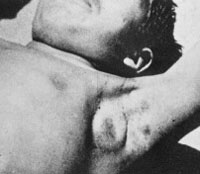BUBONIC PLAGUE
Plague is characterized by a rapid fever. If it is not quickly and correctly treated, Plague can follow a toxic course, resulting in shock, multiple-organ failure, and death. In humans, the three principal forms of Plague are bubonic, septicaemic, and pneumonic. Bubonic plague, the most common form, is almost always caused by the bite of an infected flea.
Bubonic plague usually has an incubation period of 2 to 6 days, occasionally longer. Typically, the patient experiences chills; fever, with temperatures that rise within hours to 38°C; myalgias (muscular pains); arthralgias (joint pains); headache; and a feeling of weakness. Soon, usually within 24 hours, the patient notices tenderness and pain in one or more lymph nodes near to the site of inoculation of the Plague bacillus. Because fleas often bite the legs, inguinal nodes are most commonly involved; axillary and cervical nodes are next most commonly affected.
The enlarging bubo becomes progressively painful and tender. The patient usually limits movement, pressure, and stretch around the bubo. The surrounding tissue often becomes swollen and the skin may be red, warm, and tense. Inspection of the skin surrounding the bubo sometimes reveals the site of a fleabite marked by a small pustule or ulcer.
Treated in the uncomplicated state with an appropriate antibiotic, bubonic plague usually responds quickly, with alleviation of other systemic manifestations over 2 to 5 days. Buboes often remain enlarged and tender for a week or more after the initiation of treatment.
Without effective antimicrobial treatment, patients with typical bubonic plague manifest an increasingly toxic state of fever, tachycardia, lethargy leading to prostration, agitation and confusion, and (occasionally) convulsions and delirium.
Sometimes a superficial bubo is not found in a patient infected with Plague. The infection can be in deeper abdomen.
